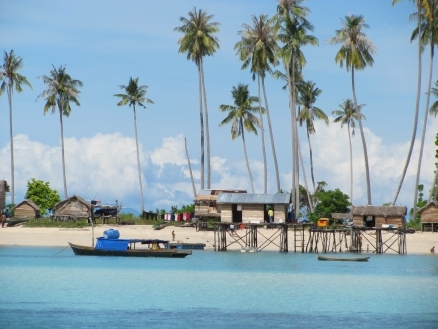Malaysia - Coastal and Marine Ecosystem Factsheet (WRI)
| Topics: |
Contents
- 1 Introduction Malaysia (Malaysia - Coastal and Marine Ecosystem Factsheet (WRI)) is situated in southeast Asia. It consists of two regions: Peninsular Malaysia in the west lying between Thailand and Singapore, and the eastern states of Sabah and Sarawak located in the east on the island of Borneo. The two regions are separated by the South China Sea. The total land area of the country is 328550km². Malaysia is a federal country, divided into thirteen states plus the federal territories of Kuala Lumpur and Labuan Island..
- 2 Factsheet
- 3 References and Further Reading
- 4 See Also
Introduction Malaysia (Malaysia - Coastal and Marine Ecosystem Factsheet (WRI)) is situated in southeast Asia. It consists of two regions: Peninsular Malaysia in the west lying between Thailand and Singapore, and the eastern states of Sabah and Sarawak located in the east on the island of Borneo. The two regions are separated by the South China Sea. The total land area of the country is 328550km². Malaysia is a federal country, divided into thirteen states plus the federal territories of Kuala Lumpur and Labuan Island..
The World Resources Institute (WRI) is an environmental think tank that goes beyond research to find practical ways to protect the earth and improve people's lives.Itsmission is to move human society to live in ways that protect Earth's environment and its capacity to provide for the needs and aspirations of current and future generations. WRIhas createdEarthTrends, an online collection of information regarding the environmental, social, and economic trends that shape our world. Committed to the principle that accurate information drives responsible decisions by governments and individuals, EarthTrends offers the public a large breadth of statistical, graphic, and analytical data in easily accessible formats.
Factsheet
| MALAYSIA | ASIA (excl. Middle Eaast) | WORLD | |
|
COASTAL STATISTICS, 2000 |
|||
| Length of coastline {a} (km) | 9,323 | 288,459 | 1,634,701 |
| Percent of population within 100 km of the coast | 98% | X | 39% |
| Area of continental shelf (km2) {b} | 335,914 | 5,514,288 | 24,285,959 |
| Territorial sea (up to 12 nautical miles) (km2) | 152,367 | 5,730,868 | 18,816,919 |
| Claimed Exclusive Economic Zone (km2) | 198,173 | 11,844,193 | 102,108,403 |
|
COASTAL BIODIVERSITY AND PROTECTED AREAS DATA, 1990s |
|||
| Area of Mangrove Forests (km2) | 1,659 | 40,330 | 169,452 |
| Percent of Mangrove forests protected | 7% | 27% | 13% |
| Number of Mangrove Species | 36 | 51 | 70 |
| Number of Seagrass Species | 9 | 27 | 58 |
| Number of Scleractinia Coral Genera {c} | 72 | 79 | X |
| International Legal Net Trade in Live Coral, 1997 (number of pieces) {d} | -130 | -773,430 | X |
| Number of Marine or Littoral Protected Areas,1999 | 111 | 831 | 3,636 |
| Wetlands of International Importance, Extent (km2), 2000 | 384 | 31,212 | 730,116 |
|
FISHERIES PRODUCTION |
|||
| Average Annual Capture (excludes aquaculture) in metric tons: | |||
| Marine Fish, 2000 | 1,257,573 | 36,516,371 | 84,411,066 |
| Mulluscs and Crustaceans, 1997 | 187,864 | 7,959,125 | 12,055,801 |
| Aquaculture Production (in metric tons): | |||
| Total (includes freshwater), 2000 | 167,898 | 41,305,773 | 45,715,559 |
| Marine and Diadromous Fish, 1997 | 12,813 | 1,325,644 | 2,623,888 |
| Mulluscs and Crustaceans, 1997 | 70,244 | 8,677,590 | 9,889,688 |
| Aquatic Plants, 1997 | X | 7,123,694 | 7,241,754 |
|
FISH CONSUMPTION AND TRADE, 2000 |
|||
| Per Capita Food Supply from Fish and Fishery Products (kg/person) | 58 | 18 | 16 |
| Fish Protein as a% of Total Protein Supply | 21% | 10% | 6% |
| Annual Trade in Fish and Fisheries Products Imports (thousand $US) | 299,603 | 22,787,200 | 60,008,337 |
| percent change since 1980 | 319% | X | 275% |
| Exports ( $US) | 199,001,000 | 16,839,046,000 | 54,570,489,000 |
| percent change since 1980 | 57% | 403% | 258% |
|
FISHING EFFORT, BOTH FRESHWATER AND MARINE |
|||
| People Employed in Fishing and Aquaculture, 2000 | 100,666 | 28,890,352 | 36,116,329 |
| Docked Fishery Vessels, 1995-98 (number) {e} | 17,272 | 1,080,625 | 1,297,017 |
References and Further Reading
- Coastal and Marine EcosystemsWorld Resources Institute
See Also
- Malaysia Geography Collection
